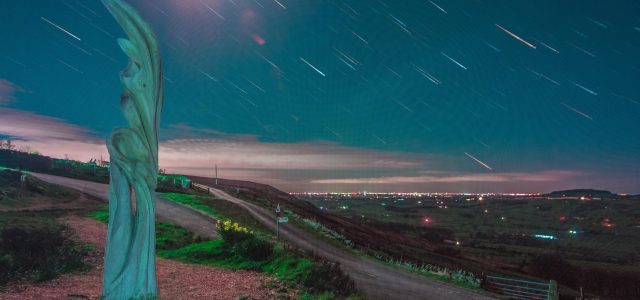
NIGHT SKIES…
The dark skies and the beautiful landscape of the Forest of Bowland have provided the inspiration for a number of exciting projects, writes Jan Woolley
As a designated Area of Outstanding Natural Beauty (AONB), the Forest of Bowland is a stunning area of dramatic, unspoilt countryside.
During the summer months the panoramic vistas over the forests and fells are regal and serene, while during winter the landscape becomes wild and windswept.
Depending on the season, the daytime sees bright, clear blue skies or stormy clouds, grey on the horizon. While at night, the Forest of Bowland becomes one of the darkest places in the UK which lights up with constellations, galaxies and stars not normally seen by the naked eye.
In an exciting project, the AONB team behind the Forest of Bowland recently succeeded in achieving Dark Sky Discovery Site status – a national initiative that attracts stargazers throughout the UK to the Ribble Valley and beyond.
The Dark Sky Discovery Site bid saw physicist and astronomer Robert Ince, working with the AONB, assessing the sky at night, how it is affected by light pollution and identifying the best and darkest sites to stargaze. He provided all the technical data and photographs to support the application.
There are very few Dark Sky Discovery Sites in the UK as most areas, even in the countryside, are affected by lights from towns and cities, as Ince explains: “Western Europe and the east coast of America are as bad as each other and they are probably the worst places in the world when it comes to light pollution. It is mostly street and motorway lighting that pollutes the darkness of the night skies.
“Clitheroe has bad light pollution and this affects the night skies over Pendle. But the Dark Sky initiative is not so much about campaigning to reduce light pollution, it’s more about being able to enjoy the night skies.”
Ince identified a number of Bowland sites where light pollution is minimal, these include Beacon Fell, Bowland Knotts, Slaidburn, Gisburn Forest Hub, Barley Green and the Crook O’Lune. Dark Sky Discovery Site status, is awarded by the Royal Observatory, Edinburgh.
Part of his assessment of suitable sites was visual and based on how many of the faint stars can be seen in the Bowland night sky – this is known as the ‘limiting visual magnitude’ – a scientific scale, grading the faintest magnitude of a celestial body by the naked eye and is dependent on sky transparency.
“We are used to people visiting the Forest of Bowland because it is such a beautiful area with AONB status, which protects it. But the night sky is also a natural landscape that needs protecting too. The Dark Sky Sites are fantastic – people don’t know what they’re missing,” says Lancashire-based Ince, who is first and foremost a physicist.
Having studied physics and astronomy at university, he went on to work as a scientist for the Ministry of Defence. However his love of astronomy has never waned: “I used to live in a small mining village and I remember, as a boy, looking up at the night sky and having a total fascination with the stars.”
After his 15 year stint at the MoD he was brought to Lancashire with his work for BAe Systems.
“Where I live, I can hardly see any stars in the night skies due to light pollution from the motorway. In the Forest of Bowland, you can literally see thousands and thousands. You can see the Milky Way, the galaxy in which we live, you can see shooting stars. It’s amazing!”
“A telescope is simply a ‘light bucket’ capturing lots of light that enables you to see stars and galaxies thousands of millions of light years away. The light has been travelling millions of miles before you have even seen it.”
“I have seen stars explode – supernovae – which are really bright and I never fail to be amazed by the rings of Saturn.”
Ince is also an accomplished night sky photographer and captures much of his stargazing on camera to produce beautiful time lapse images and stills.
The stargazing season, when the nights start to get darker, is just beginning.
“At the moment tourism is very seasonal but astro-tourism can change that, attracting people to the area all year round.”
“More and more people are interested in astronomy and that’s partly down to people like Professor Brian Cox. He attracted around five million viewers for one of his television programmes, which is amazing considering astronomy is basically all about science.”
“Most people don’t find science a turn-on but when you are looking at stars light years away, you are learning about how light travels, which is physics. When you see the planets you learn about geology. It is really exciting and interesting.”
“I love showing people the night skies, explaining what can be seen by the naked eye and what can be seen through a telescope. Astronomy has a real ‘wow’ factor and it’s great for me to have a job that I love doing.”

